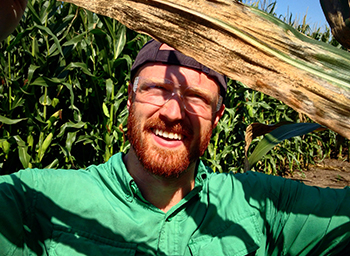Research Conducted by:

Blake Webster, M.S. Student
Advised by: Dean Malvick
Goss’s wilt, a reemerging threat to corn yields, is appearing in fields across Minnesota and the northern corn growing region. First confirmed in Minnesota in 2009, this disease is a concern for researchers like graduate student Blake Webster because of its potential to reduce corn yields by as much as 50 percent. While there are currently recommendations for disease control measures, Webster is taking a holistic, three-pronged approach to learn more about this disease and discover additional methods of disease management.
Webster is analyzing the genetic diversity of the bacterial pathogen (Clavibacter michiganensis subsp. nebraskensis) that causes the disease. This research however may actually reveal that different isolates of the pathogen have different resistance needs,” says Webster, adding that currently no corn hybrids are completely resistant to Goss’s wilt. Having a snapshot of the pathogen’s genetic profile will help find the best way for breeders to create hybrids that are widely resistant to the pathogen.
Webster’s second research objective is investigating whether methods that growers are using to manage other plant diseases are creating more favorable conditions for Goss’s wilt. Webster is assessing how Goss’s wilt progresses when exposed to different agrochemicals. Generating this data will help provide appropriate management strategies for growers seeking to effectively control all plant diseases their fields may face.
Preventing the Goss’s wilt pathogen from infecting corn is a just one piece of the control puzzle since the same pathogen may infect other plant species as well. Webster is conducting a host range study to see if plant species commonly associated with corn can host the bacteria year after year. “If these species are serving as an inoculum source for the pathogen, growers would need to be effectively controlling these plants in order to prevent the disease from subsequently infecting corn,” says Webster.
Ultimately Webster and his research team aim to provide research-based information to help growers make informed, sustainable disease management decisions. “We’re looking for control measures but they also have to be environmentally friendly, cost-effective and reasonable for growers to adopt. If the research we are doing contributes to finding control mechanisms that allow all of those facets to be fulfilled we will be happy.”
